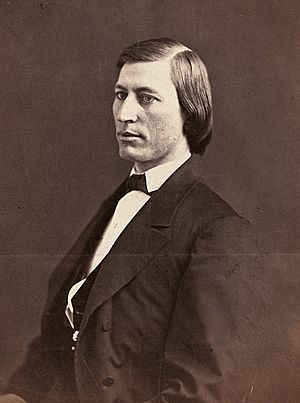Henry Clay Pate facts for kids
Henry Clay Pate (born April 21, 1833 – died May 11, 1864) was an American writer, newspaper owner, and soldier. He strongly supported slavery. He was involved in the "Bleeding Kansas" conflicts, where people fought over whether Kansas would allow slavery. Pate is most famous for his clashes with, and being captured by, John Brown, who was against slavery.
Contents
Early Life and Education
Pate was born in Bedford County, Virginia, in 1833. His father, Edmund Pate, had fought in the War of 1812. Henry Clay Pate began studying at the University of Virginia in 1848. However, he left the university after two years without finishing his degree. After leaving school, he lived for a while in Cincinnati, where he worked as a writer. Later, he moved to Kansas.
The "Bleeding Kansas" Conflict
In the 1850s, Kansas was a place of great conflict. People who supported slavery and those who wanted to end it fought violently. This period is known as "Bleeding Kansas" because of the bloodshed. Henry Clay Pate was strongly on the side of those who supported slavery.
Pate's Role in Kansas
Pate started a newspaper called the Westport Border Star. This newspaper supported slavery. In 1855, he became a Justice of the Peace in Kaw Township, Jackson County, Missouri. Pate also took part in the sacking of Lawrence, an attack on an anti-slavery town. Around this time, he became a Deputy United States Marshal.
Hunting John Brown
When Pate heard about John Brown's actions at the Pottawatomie Massacre, he decided to hunt Brown down. Pate gathered about thirty men to help him. During this search, two of John Brown's sons, Jason and John Junior, were taken into custody. They were charged with serious crimes and put in chains.
The Battle of Black Jack
John Brown quickly responded to Pate's actions. Pate's group was camped near the Santa Fe Trail in Douglas County, Kansas. At dawn on June 2, 1856, Brown and a small group of anti-slavery fighters attacked. This led to a fierce, three-hour fight known as the Battle of Black Jack.
Even though Brown's group had fewer men, they won. Many of Pate's men ran away, and the rest were captured. Pate tried to surrender with conditions, but Brown refused. So, Pate surrendered without any conditions.
After the Battle
Later, Governor Shannon sent federal troops to free Pate and his men. Lieutenant J. E. B. Stuart was with these troops. Pate would later serve with Stuart in the Civil War. About his defeat, Pate famously said, "I went to take Old Brown, and Old Brown took me."
Pate's connection with John Brown continued. Brown took Pate's Bowie knife as a prize. He used it when giving speeches. Later, he even used it as a model for the weapons he planned to give to freed slaves during his raid on Harpers Ferry.
Meeting Brown in Jail
After John Brown was captured, Pate traveled about 175 miles from his home in Petersburg, Virginia, to Charles Town. He went there to visit Brown in jail. They worked together to write a statement about what happened at the Battle of Black Jack. This statement somewhat defended Pate. Brown even said that Pate "gave him the hardest fight he had in Kansas."
John Brown was hanged on December 2. A few days later, on December 7, Pate gave a public talk about Brown at Cooper Union. In his talk, Mr. Pate spoke well of himself and less favorably of Brown.
Civil War Service and Death
When the Civil War began, Pate was living in Petersburg, Virginia. He formed and equipped a company of mounted soldiers. This unit was known by several names, including Pate's Rangers. They received weapons from the Gosport Navy Yard. Pate also designed a special revolving cannon for his unit.
His company joined Wise's Legion and was sent to western Virginia. Later, Pate served under Thomas L. Rosser. Rosser felt Pate was difficult to work with and disobedient. Pate was even put on trial by a military court, but he was found innocent.
Pate died at the Battle of Yellow Tavern. He had been ordered by General J. E. B. Stuart to hold his position until more soldiers arrived. During the second part of the battle, Pate held his ground as ordered. He was then killed by a bullet.


